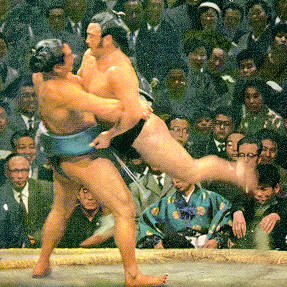
Sumo

Sumo is a very popular sport in Japan. It was established almost 2000 years ago. Basically you have two huge men in a circular ring. Their task is to either push their opponent out of the ring, or get their opponent to touch the ring surface with some part of their body other than their feet. They often eat ten or more times as much as the average man and drink quantities of sake and beer, disregarding all the training rules so rigorously followed in the Western world. They appear to be overburdened with fat but underneath the fat constant practice gives their muscles great power and flexibility. Also, as many of the rules are based on principles of leverage, weight counts to advantage. They habitually wear their hair long, twisted into a knot on the crown of the head, in the samurai manner.
(Source: We Japanese: Being descriptions of many of the customs, manners, ceremonies, festivals, arts and crafts of the Japanese besides numerous other subjects. Fujiya Hotel. Ltd. 1950 version.)
The outer edge of the wrestling ring is square. The small elevated platform rests on a foundation of heavy straw rice-bales. The ring itself is 12 ft. in diameter, is sanded, its boundary line being marked by a double circle of thick straw ropes about 4 in. apart, half-buried in the sand, the inner circle constituting the stage of the contest. From each corner of the platform rise slanting pillars of wood that support a roof, the pillars draped in red, black, green and white for the four directions of the compass, the roof draped in purple bunting. At each pillar sit retired wrestlers, the trainers, who act as judges in disputed cases. By lifting or lowering the flag, the umpire emphasizes his orders.
We see the Japanese culture displayed even in sumo. At the start of the match the wrestlers will throw salt around the ring and stamp their feet. The salt container is called the shioire. When the wrestlers are making their ceremonial moves they will squat. This represents a way of showing respect to one's better in olden days. When the wrestlers raise one of their legs and arms high then stamp they down they are symbolically crushing any evil spirits that may be in the ring.
Anyone thing that the wrestlers will do is to clap their hands twice and spread out their arms. This is to show they are not carrying any concealed weapons. They then squat down on their marks and glare at each other, trying to psyche out the other wrestler.
The winner is determined by which person first makes his opponent step outside the ring or touch the ground (in or out of the ring) with any part of his body other than his feet.

It's not, of course, just a matter of sheer bulk. A lot of training and skill go into the fights and regular tournaments are held. The wrestlers belong to training stables called heya and they do not fight each other but only wrestlers from other heya.
The highest rank a wrestler can achieve is yokozuna. They generally voluntarily retire once their wrestling skills start to fade.
To get promoted to a higher lever a wrestler has to win eight or more of the fifteen bouts that make up a tournament. The lowest level is referred to as juryo; above that is the maegashira, then the komusubi, then the sekiwake, and then the ozeki and finally the yoiozuna. If an ozeki wrestler ends up with eight or more losses in two consecutive tournaments, though, they are demoted.

Main Index
Japan main page
Japanese-American Internment Camps index page
Japan and World War II index page
|